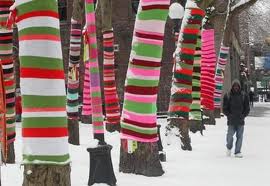When we lived in Buffalo, we became warriors in the gypsy moth battle. One of the things we quickly learned was to check tree trunks for larvae, especially those trees with thick, rough bark where caterpillars could hide. It went without saying that burlap used to insulate tender plants came off as soon as possible in the spring, because that burlap was a great place for larvae to live as well.
Back in Washington state, we don’t have a gypsy moth infestation (yet), but the lesson was retained: we don’t leave materials wrapped around the trunks or branches of trees. Other pests would find them just as hospitable as gypsy moths, and the dark, moist conditions would be wonderful for disease development.

So imagine my horror this morning when the Sunday paper featured the latest Seattle art – Tree Socks. These knit installations are appearing on trees in public spaces. Don’t get me wrong – I love art – but this just seems like a bad idea waiting to happen.
Why not dress up utility posts and light poles instead? They’re certainly more in need of aesthetic improvement than trees.
I like the look of these leggings (trunkings?), but can see how a long-term installation might be a problem. As a temporary installation — say, a couple of weeks, or some period like Christo’s Gates in Central Park, would they still be so bad?
(I tried to give an answer to the Friday quiz, but some glitch prevented my making a comment, so I had to turn away, Holly’s maniacal laughter ringing in my ears. Might that photo be some kind of maple flower head? Crossed with a lilac and a daphne mezereum and a passion flower? )
Here in Sacramento, a few trees are dressed in socks, but more & more I see them on light poles, support columns, and bike racks (my fave, especially when it’s one of those long-and-loopy types). Although I agree trees are pretty enough without this extra ornamentation, it does look cool in that photo with the snow off-setting the brilliant colors.
As for garden lessons … I have so many, and almost all in the don’t-do-this category. Will see if I still have some photo evidence of such.